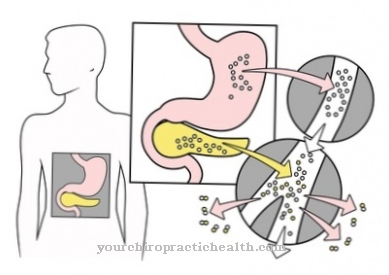The Membrane permeability characterizes the permeability of molecules through the cell membrane. All cells are separated from the intercellular space by biomembranes and at the same time contain cell organelles that are in turn surrounded by membranes. The permeability of the membranes is necessary for the smooth running of the biochemical reactions.
What is the membrane permeability?

The membrane permeability is defined as the permeability of the biomembrane for liquids and dissolved substances. Cell membranes, however, are not permeable to all substances. Therefore, they are also referred to as semipermeable membranes (semi-permeable membranes).
Biomembranes consist of two phospholipid layers that are permeable to gases such as oxygen or carbon dioxide as well as lipid-soluble, non-polar substances. These substances can pass through the membranes via normal diffusion. Polar and hydrophilic molecules are not allowed through. They can only be transported through the membrane via passive or active transport processes.
Membranes protect the inner cellular space and the space within the cell organelles. They ensure the maintenance of special chemical and physical conditions for important biochemical reactions without external interference.
The permeability of the membranes ensures the selective transport of vital substances from the extracellular space into the cell and the removal of metabolic products from the cell. The same applies to the individual cell organelles.
Function & task
Membranes are absolutely necessary for the undisturbed process of vital biochemical reactions within the cells and the cell organelles. The membrane permeability is just as vital in order to be able to supply the cells with important nutrients such as proteins, carbohydrates or fats. Minerals, vitamins and other active ingredients must also be able to pass through the membrane. At the same time, metabolic products are created that have to be disposed of from the cell.
However, the membranes are only permeable to lipophilic molecules and small gas molecules such as oxygen or carbon dioxide. Polar, hydrophilic or large molecules can only be transported through the membrane via transport processes. There are passive and active options for membrane transport for this.
Passive transport works without supplying energy in the direction of a potential or concentration gradient. Smaller lipophilic molecules or gas molecules are subject to normal diffusion. Normal diffusion is no longer possible with larger molecules. Certain transport proteins or channel proteins can facilitate transport here. The transport proteins span the membrane like a tunnel. Smaller polar molecules can be passed through this tunnel via the action of polar amino acids. This also enables the transport of small charged ions through the tunnel.
Another passive transport option results from the action of carrier proteins that specialize in certain molecules. When the molecule docked, they change their conformation and transport it through the membrane.
In the case of active membrane transport, the supply of energy is necessary. The corresponding molecule is transported against a concentration gradient or an electrical gradient. Energy-supplying processes result from the hydrolysis of ATP, the build-up of a charge gradient in the form of an electric field or the increase in entropy by building up a concentration gradient.
Endocytosis or exocytosis is available for substances that cannot penetrate the membrane at all. In endocytosis, the invagination of the biomembrane takes in a drop of liquid and transports it into the cell. This creates a so-called endosome, which transports important substances into the cytoplasm. During exocytosis, waste products in the cytoplasm are carried outwards by membrane-covered transport vesicles.
Illnesses & ailments
Disturbances in membrane permeability can lead to various disease states. The changes affect the permeability of the various ions. Membrane permeability disorders are often the result of cardiovascular diseases. This can affect the body's electrolyte balance.
However, many hereditary causes also cause membrane permeability disorders. Various proteins are involved in the structure of the membrane and are responsible for the correct function of the lipid bilayer. Genetic changes in certain proteins are responsible for changes in membrane permeability, among other things.
One example is the disease Myotonia congenita Thomsen. This disease is a genetic disorder of muscle function. A gene that encodes the chloride channels of muscle fiber membranes is mutated. The permeability of the chloride ions is reduced. This leads to an easier muscle fiber depolarization than in healthy people. The tendency to muscle contraction is increased, which is felt as stiffness. For example, a closed fist can only be opened with a certain delay. The eyes can only be opened after 30 seconds after closing, which is known as lid-lag.
There are also autoimmune diseases that specifically target biomembranes. In this context the so-called antiphospholipid syndrome (APS) is known. In this disease, the body's immune system is directed against proteins that are bound to the phospholipids in the membrane. The result is an increased coagulability of the blood. The likelihood of heart attacks, strokes and pulmonary embolisms is increased.
Disturbances of the membrane permeability can also be found in the so-called mitochondriopathies. In the mitochondria, energy is obtained from the burning of carbohydrates, fats and proteins. The mitochondria are cell organelles that are also surrounded by a membrane. A large number of free radicals are produced within these energy power plants. If these are not captured, the membranes will be damaged. This severely limits the function of the mitochondria. The causes for the reduced effectiveness of the radical scavengers are diverse, however.






.jpg)

















.jpg)



